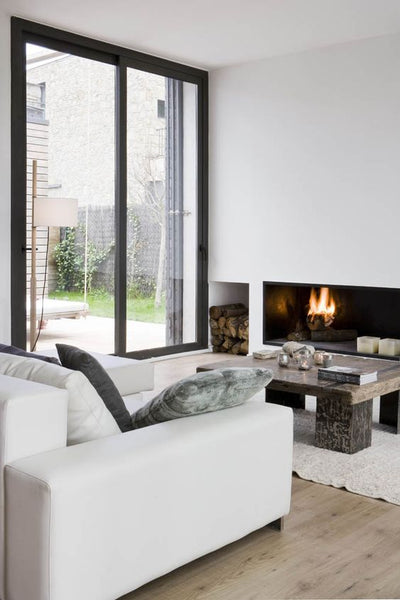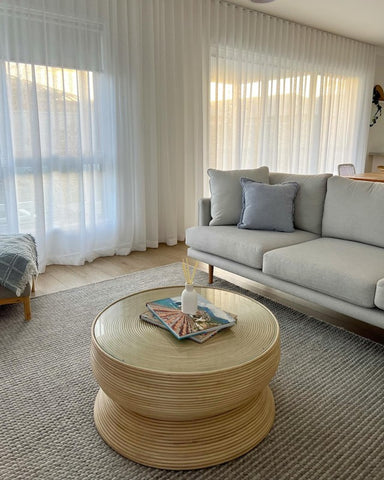Transforming compact living spaces into stylish sanctuaries is easy with these few steps. Smaller spaces require less furniture and decorative items, and they also can feel more homely. At Urban Rhythm, we understand that living large can still come in a small luxurious package. Whether you're navigating a cosy apartment, a new townhouse, or a compact cottage, try these savvy solutions to optimise your space.

While you may have chosen to downsize, creating the feeling of space is still high on the priority list for many. It’s one thing to have a small home and another to have one that feels pokey, cramped and bordering claustrophobic.
Thankfully, you don’t need to knock down walls or think of creative ways to extend the footprint to make your space feel more spacious. Try some of these tips and your focus will be less on your home’s petite proportions and more on its style.
1. Use lighter shade paint colours
Lighter paint colours will reflect the natural light and make the room feel larger. Darker colours on the other hand, will make the space seem cosier and more intimate. If you’re after a more spacious feeling, opting for a light and neutral colour palette will be more effective. Think pale colours like creams and whites.
Sticking with one shade rather than creating feature walls will also help enhance the proportions of your space. If you want some variation in the room’s colours, you could paint the skirting, window and door trims in one shade lighter than the rest of the room.
When considering your paint colours, take into account the other surfaces in your room, particularly your floors. You’ll want to make sure the two are in the same colour story. This will create visual cohesion and balance rather than highlighting the differences in surfaces.
2. Create flow through flooring

Continuing the one flooring type throughout your home will make a huge difference in the feeling of space. Laying floorboards is a great solution as these can be used in various rooms including the living spaces, kitchen areas, and bedrooms.
Adding rugs is an effective way to add warmth without visually shrinking your space. When choosing a rug, it’s best to refrain from something that has many designs. Instead, stick with a simple design like the Diva rug at Urban Rhythm. These rugs are a handwoven collection that ensures the focus remains on the contemporary colours and texture of handloom knotted rugs in 100% pure wool.
Textured lines like the Marco Rug will provide interest without being too busy. Also, when you position the textured lines running the longest length of the room, it will make the space feel bigger.
If you need advice on finding the right rug size for your space, click here.
3. Take the doors off
If knocking through walls to create larger openings isn’t an option, taking internal doors off may be a solution. If your doors open into a room, it can up valuable floor space and interrupt the flow of the home. You could remove the door altogether or simply replace it with a sliding door.
In small spaces, every millimetre counts. This simple change could also work well in rooms that have cupboards on a hinge such as bedroom closets or bathroom cabinetry.
4. Opt for minimalist window treatments

Photo Source: nordicdesign.ca
In small spaces decorative window treatments such as valances and curtains in luxurious fabrics not only take up precious real estate, but they also make a room feel smaller.
Instead, opt for minimalist window treatments such as rolling blinds in the same fabric as the walls. This will allow you to cover the window without encroaching on your space.
Another alternative if you wish to hang curtains is to install a track on the ceiling rather than the walls. Use a light fabric such as a linen, hang the curtains all the way to the floor to exaggerate the height of your room. This can be especially effective in rooms where you don’t require full block out window treatments.
5. Use mirrors

If you’re working with a tight budget or need a quick solution to make your rooms feel larger, use mirrors. Mirrors work by retracting sunlight, allowing it to bounce around the room and giving the illusion of space.
Leaning a couple of oversized full-length mirrors against a wall or hanging multiple on a wall can be just as effective and less permanent.
To steal more light or to enhance your view, artfully position the mirrors so that they reflect a window and the view outside.
6. Furnish carefully

Urban Rhythm's Melba Sofa
Where many people go wrong when decorating petite spaces is filling them with smaller furniture pieces. Sure, an oversized deep modular sofa may not be appropriate, but believe it or not, furnishing your home with a few bigger pieces can make a space feel larger.
Be thoughtful when choosing furniture for your small space. Opt for fewer, statement pieces in plain fabrics instead of multiple. Invest in furniture that can serve many purposes such as an ottoman that also works as a coffee table or a coffee table with built-in storage.
If you’re searching for a sofa for your small living room, look for one which is elevated off the ground. When finding the right dining chairs, choose ones that have an open frame. Swap your rectangular dining table for a round piece. These are just some of the tricks to give the illusion of more space through furniture choices.
How you position your furniture should also be taken into consideration. Space out your furniture so that it allows the space to breathe. Pull the furniture out from the wall slightly. Angle your bed in the room rather than pushing it into one corner. Use side tables to flank a sofa rather than a large coffee table that could be blocking the rooms flow.
7. Decorate with restraint

Lastly, decorate your space with restraint. In your previous, much larger home, you may have had the freedom to add personality through endless decorative items such as art, books, vases and figurines.
In smaller spaces, you need to be much more selective about what you choose to display if your aim is to make the proportions feel bigger. Select a few items you cherish to place in the room rather than a smorgasbord of your favourites. Once you’ve arranged these items in the room, remove one or two until you’ve achieved the perfect balance between visual interest and restraint.
